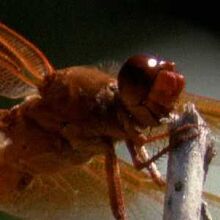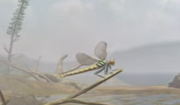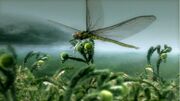
A dragonfly from Walking with Dinosaurs.
Dragonflies were some of the first insects to have evolve flight - the giant insect Meganeura, possessing a wingspan of 70-75 cm, was the size of some modern eagles with an appetite to match. It lived in the swamps of Western and Central Europe during the Carboniferous time period (around 311 MYA or so), and resembled a modern dragonfly in shape, behavior and development - its larvae lived in swamps, underwater, and ate various animals smaller than they were, such as tadpoles and small fish.
In the Walking with... Series[]
Walking with Monsters[]
Reptile's Beginnings[]

A dragonfly in Wonderbook.

Meganeura with a Petrolacosaurus.
A dragonfly relative, Meganeura, was shown as a dangerous predator to early reptiles in the Carboniferous. However, by early Permian, the high oxygen content of the earlier Carboniferous period had shrunk, causing larger insects like Meganeura to go extinct and surviving species to shrink in size. An unidentified species of dragonfly was seen briefly being harassed a pair of Edaphosaurus.
Clash of Titans[]
Despite their dependency on water for their eggs and young, the dragonflies were among the survivors of the great Permian-Triassic extinction event and are seen thriving post-extinction event. Some are seen being hunted by a Euparkeria, a distant relative of the famous dinosaurs.
Walking with Dinosaurs[]
New Blood[]
Several of the early pterosaurs were seen hunting dragonflies.
Time of the Titans[]
Several dragonflies are seen being hunted by Anurognathus - a small rhamphorhynchoid pterosaur.
Walking with Beasts[]
New Dawn[]
Dragonflies and their relatives, having also survived the K/T extinction event, are seen thriving. An ancient mammal called Leptictidium is shown hunting damselflies - a sister clade of the dragonflies - 49 MYA, during the early Eocene time period.
Behind the Scenes[]
Dragonflies and damselflies continue to survive in modern times, even though water pollution and air pollution has taken their toll on these insects and are threatening them with extinction.
